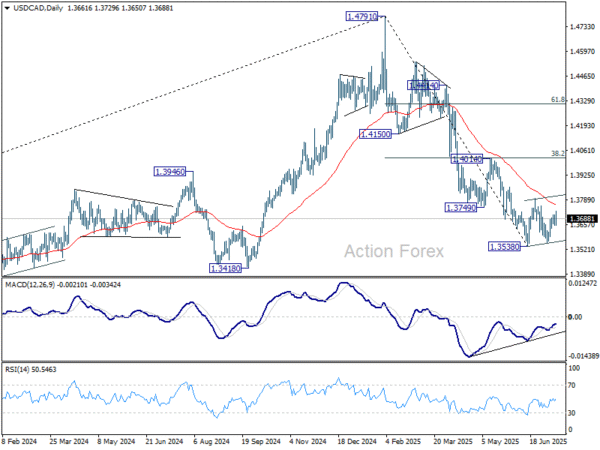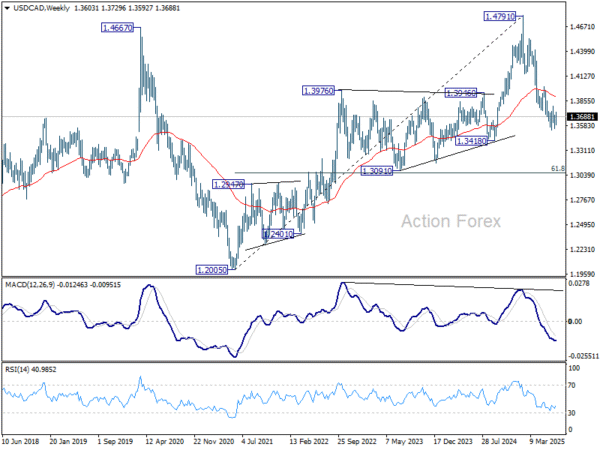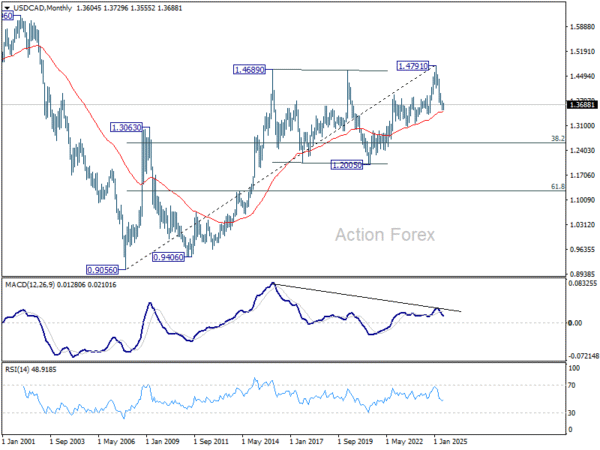Investors Brush Off Tariffs, Dollar Rebounds Near Long-Term Channel Support
Global markets brushed aside the latest escalation in the US-led trade war last week, with equities rallying to fresh record highs and risk appetite proving remarkably resilient. Overall, the muted investor response suggested markets were pricing in the tariff headlines as more bark than bite, at least for now.
Aussie led pack, benefiting from a perfect storm of positive drivers: firm risk sentiment, surging copper prices, and a surprise decision by the RBA to hold rates steady. Dollar followed closely as traders adjusted their Fed expectations, while Swiss Franc came in third. At the bottom of the leaderboard, Yen was the week’s worst performer, followed by a battered Pound Sterling and a soft New Zealand Dollar. Euro and Canadian Dollar were middling performers.
Looking ahead, trade developments remain in focus. Over 20 countries have now received individual tariff letters, and the administration has signaled that blanket 15–20% tariffs may apply to remaining partners. Europe remains the big unknown—with the White House expected to send tariff letters to the EU imminently. Any escalation there could test market calm and shake up the late summer outlook.
Markets shrugged off a major escalation in the US-led trade war last week, with risk appetite holding firm despite sweeping US tariffs targeting Canada, Brazil, Japan, and more than a dozen other nations. S&P 500 and NASDAQ posted fresh record highs before easing slightly into Friday’s close. In Europe, DAX and FTSE also reached new peaks. Even Japan’s Nikkei remained broadly stable, a surprise given the imposition of 25% US tariffs on Japanese products.
Under the latest round of trade actions, the US slapped a 35% tariff on Canadian imports starting August 1, threatening even higher rates if Canada retaliates. Meanwhile, Brazil was hit with 50% tariffs, making it the most targeted country to date. Other nations that received tariff letters were hit ranging from 20% to 40%. Countries without letters are expected to face blanket tariffs of 15–20%. Additionally, the US announced a 50% tariff on all copper imports, citing national security concerns under a Section 232 investigation.
Despite the surge in trade frictions, markets largely responded with relief. That most of the new tariffs were’nt disastrous—aside from a few headline-grabbing moves—helped keep sentiment afloat. Besides, the new August 1 deadline buys time for diplomacy, and some investors are hopeful partial deals or exemptions can still be secured. However, expectations remain low for a broad multilateral breakthrough.
Technically, near term outlook in S&P 500 will stay bullish as long as 19800.45 resistance turned support holds. The real test for the near term is the resistance zone between 61.8% projection of 10088.82 to 20204.58 from 14784.03 at 21035.56 and upper channel resistance (now at around 21250).
Rejection by this resistance zone, followed by break of 19800.45 support, will indicate short term topping, possibly with bearish divergence condition in D MACD. Consolidations should then follow with risk of deeper pullback.
As for FTSE, near term outlook will stay bullish as long as 8707.65 support holds. Sustained break of the long term channel resistance, as seen in the weekly chart, could prompt upside acceleration. Next target is 100% projection of 6707.62 to 8908.82 from 7544.83 at 9746.03.
Near term outlook in DAX should stay bullish as long as 23051.55 support holds. Current uptrend is in progress for 61.8% projection of 11862.84 to 23476.01 from 18489.91 at 25666.77.
As for Nikkei, the extended consolidations now suggests that 40852.54 is a short term top already. There is risk of deeper pullback but the first line of defense is in 55 D EMA (now at 38341.41). Strong rebound from there will keep the consolidations brief, and rise from 30792.74 should resume to retest 42426.77 high sooner rather than later. Nevertheless, firm break of 55 D EMA will likely bring deeper correction to 38.2% retracement of 30792.74 to 40852.54 at 37012.86, and followed by lengthier consolidations.
While market optimism around equities has remained largely intact despite a growing list of US tariffs and rising global trade tensions, expectations for Federal Reserve easing in the second half of the year have quietly shifted. A July rate cut was never seriously priced in, and the odds of a September cut have now slipped from around 70% to closer to 60% as investors reassess the implications of the Trump administration’s widening tariff campaign.
The issue is timing. The next FOMC decision on July 30 will precede the updated August 1 trade truce deadline, meaning the Fed will not have sufficient information to evaluate whether these new tariffs will result in temporary inflation bumps or signal something more sustained. This lack of clarity is a major hurdle for policymakers trying to calibrate their next move.
Meanwhile, minutes from Fed’s June 17–18 meeting reinforce the split between officials. While “most participants” foresee at least one cut this year based on easing inflation pressures and slowing labor demand, “some participants” argued that no cuts are necessary in 2025. Their reasoning: inflation still exceeds target, price expectations remain elevated, and the economy has shown surprising resilience. Moreover, they noted that the current policy rate is not significantly above its neutral level, reducing the urgency for loosening. Only “a couple” of officials said they’d consider a cut in July, and only with confirming data.
Dollar Index remains bearish for the near term but may be nearing a critical inflection point. Firstly, bullish convergence conditio in D MACD suggests diminishing downside momentum. Secondly, the index is now now reasonably close to decade long channel support (now at around 96). Break of 55 D EMA (now at 99.00) will bring stronger rise back to 55 M EMA (now at 101.27), or even further to 101.97 resistance.
Nevertheless, before that, further decline remains in favor. Decisive break of the above mentioned channel support would argue that whole up trend from 70.67 (2008 low) has completed, and deeper medium term fall would be seen to 61.8% retracement at 87.52, even still as a corrective move.
Australian Dollar outperformed all peers last week, closing as the strongest currency across majors. Risk-on sentiment in global markets helped fuel the Aussie’s rally, as investors shrugged off trade tensions and rotated into higher-yielding, commodity-linked currencies. Copper prices surged following Trump’s surprise announcement of a 50% tariff on copper imports, providing an additional tailwind.
Central bank policy added further momentum. RBA surprised markets by holding its cash rate steady at 3.85%, despite overwhelming expectations for a third rate cut this year. Just before the meeting ago, market pricing implied a 94% chance of a 25bps cut, and minutes from the May meeting had even revealed a discussion of a 50bps move. With inflation data softening and oil prices falling, the dovish consensus appeared firm heading into the July meeting.
But the board was clearly divided. The 6-3 vote to hold confirms that the case for easing remains active, yet the majority opted to wait for the Q2 CPI report before committing to further moves. Governor Michele Bullock emphasized that the issue was one of timing, not direction, suggesting that cuts remain on the table but will be data-driven. But for now, policy stability and commodity strength have kept the Aussie buoyant.
AUD/JPY ended as the top mover last week, gaining 2.40%. Technically, current upside acceleration, as seen in D MACD, solidifies the case that medium term corrective fall from 109.36 (2024 high) has completed with three waves down to 86.03. Further rise is expected as long as 95.37 support holds. Next target is 61.8% projection of 86.03 to 95.63 from 92.30 at 98.23. Firm break there will pave the way to 100% projection at 101.90, or even further to key medium term structural resistance at 102.39.
USD/CAD recovered last week but lost momentum quickly. Initial bias stays neutral this week first. Overall, price actions from 1.3538 are seen as a corrective pattern, which is now in its third leg. Stronger rise could be seen and above 1.3728 will target 1.3797 resistance and probably above. On the downside, break of 1.3637 minor support will bring retest of 1.3538/55 support zone.
In the bigger picture, price actions from 1.4791 medium term top could either be a correction to rise from 1.2005 (2021 low), or trend reversal. In either case, further decline is expected as long as 1.4014 resistance holds. Next target is 61.8% retracement of 1.2005 (2021 low) to 1.4791 at 1.3069.
In the long term picture, as long as 55 M EMA (now at 1.3494) holds, up trend from 0.9056 (2007 low) should still resume through 1.4791 at a later stage. However, sustained trading below 55 M EMA will argue that the up trend has already completed, with rise from 1.2005 to 1.4791 as the fifth wave. 1.4791 would then be seen as a long term top and deeper medium term down trend should then follow.
You may also like...
Diddy's Legal Troubles & Racketeering Trial

Music mogul Sean 'Diddy' Combs was acquitted of sex trafficking and racketeering charges but convicted on transportation...
Thomas Partey Faces Rape & Sexual Assault Charges

Former Arsenal midfielder Thomas Partey has been formally charged with multiple counts of rape and sexual assault by UK ...
Nigeria Universities Changes Admission Policies

JAMB has clarified its admission policies, rectifying a student's status, reiterating the necessity of its Central Admis...
Ghana's Economic Reforms & Gold Sector Initiatives

Ghana is undertaking a comprehensive economic overhaul with President John Dramani Mahama's 24-Hour Economy and Accelera...
WAFCON 2024 African Women's Football Tournament

The 2024 Women's Africa Cup of Nations opened with thrilling matches, seeing Nigeria's Super Falcons secure a dominant 3...
Emergence & Dynamics of Nigeria's ADC Coalition

A new opposition coalition, led by the African Democratic Congress (ADC), is emerging to challenge President Bola Ahmed ...
Demise of Olubadan of Ibadanland
Oba Owolabi Olakulehin, the 43rd Olubadan of Ibadanland, has died at 90, concluding a life of distinguished service in t...
Death of Nigerian Goalkeeping Legend Peter Rufai

Nigerian football mourns the death of legendary Super Eagles goalkeeper Peter Rufai, who passed away at 61. Known as 'Do...







